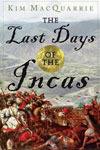
Last Days of the Incas
Kim MacQuarrie
It is serendipitous that this book came out within a few months of my trip to South America. A history book that reads like a novel, it provided much needed context for what I’d seen. It begins and ends with Machu Picchu, from about 1400 to the present. The story really starts with Francisco Pizarro’s “discovery” of the Incas, and kidnapping of the emperor Atahualpa. The author makes the important point that the Conquistadors were not military men, but “entrepreneurs with swords.” They took over Cusco (the “navel” of the Inca world) and Saxawaman. They informed their captives of The Requirement that concludes by blaming the victims if they get hurt, “the deaths and losses which shall accrue from this are your fault.” Many pages are devoted to the rebel Manco Inca and his progressive movement to Pisac, Ollantaytambo, and beyond in an attempt to evade the Spaniards. The book concludes with a summary of recent discoveries, intrigues and fraud.

